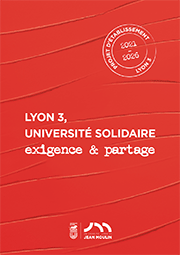AccueilRechercheProgrammes et productions scientifiquesThèsesThèses soutenuesThèses soutenues - 2006-2021Thèses soutenues - 2012
-
Partager cette page
- Recherche,
QUEGUINER Jean-Sébastien
Qualification et détermination de la compétence spéciale. L'exemple de la matière contractuelle
Publié le 11 juillet 2012 – Mis à jour le 13 juillet 2017
Thèse en droit comparé soutenue le 16 avril 2012

Le droit international privé de l’Union européenne se réapproprie le problème de la qualification. Non content d’en altérer fondamentalement la configuration, il en réoriente laborieusement la résolution.
Or, la qualité du système tout entier, sa stabilité à un instant t, de même que sa capacité à se développer, à s’ouvrir et à se déployer sur le monde extérieur, sont placées dans l’étroite dépendance de l’efficacité de la qualification ; efficacité qui se mesure à l’aune de l’analyse méthodologique de l’opération, comme de la cohérence des résultats auxquels elle conduit.
Et si à ce titre le système dé?oit aujourd’hui, il est néanmoins tout aussi possible que souhaitable de le refonder rationnellement. Qui peut le plus peut le moins… Exemple sera donc pris de la matière contractuelle, soumise à la règle la plus complexe qui soit, la plus sujette à polémiques aussi, afin d’ouvrir la voie à davantage de cohérence.
La reconfiguration du problème de qualification, ayant sa source dans la rupture imposée par le droit de l’Union entre la législation matérielle et la législation conflictuelle, en accentue naturellement la complexité. Curieusement, la construction jurisprudentielle multiplie sans raison les difficultés, imposant deux nouvelles ruptures, entre l’interprétation de la catégorie érigée au fondement de la compétence et l’interprétation du facteur de rattachement d’une part, entre l’opération de qualification et l’opération de coordination des compétences concurrentes d’autre part.
La refondation du système de qualification suppose ainsi la combinaison harmonieuse de ce que la jurisprudence a dispersé, qualification, rattachement et coordination concourant conjointement à la détermination de la compétence spéciale, la cohérence des résultats de la qualification déterminant le choix des orientations méthodologiques de l’opération.
Dans cette perspective simplificatrice, parce que la complexité des réponses juridiques ne se con?oit que lorsqu’elle reflète adéquatement et efficacement la complexité des questions, il appara?t naturel de confier à l’opération de qualification les moyens de prévenir les difficultés que ne manque pas de susciter sa pratique purement analytique, cause naturelle d’un dépe?age des situations entra?nant à son tour une dispersion excessive du contentieux. Appuyé au contraire sur une opération de qualification à visée préventive, et recourant à des catégories plus synthétiques aux contours flexibles, le système de détermination de la compétence spéciale en matière contractuelle gagnerait en simplicité, en efficacité, en adaptabilité, et il pourrait peut-être être envisagé, enfin, de donner une dimension mondiale à ce qui fonctionnerait à l’échelle régionale.
Formally disassociating the sources of material and conflict legislation, European Private International law alters the classical problem of characterisation, resolution of which cannot be borrowed from BARTIN or RABEL theories any longer. Yet, the quality of the whole system, its stability at a given moment, as well as its capacity to develop and to deploy on the outside world, are placed in the narrow dependence of the efficiency of the characterisation process. Analysing this efficiency calls for an examination of the theoretical and methodological implications, as well as of the consistency of the achieved results.
On both grounds, the current system of characterisation is undoubtedly disappointing, and should be reconsidered rationally. In this perspective, attention will be focused on “matters relating to contract”, submitted to the more complex and criticized rule of the Brussels I regulation.
The importation of a conflict of laws issue within a conflict of jurisdiction reasoning (De Bloos/Tessili) constitutes a terrible factor of complexity, interpretation of the conflict category belonging to the European legal order while the interpretation of the connecting factor is abandoned to the national legal order. As a consequence, the reasons behind the choice of a specific connecting factor simply cannot impact the characterisation process, as the exclusion of all claims formed by third parties from the scope of article 5-1° illustrates (Handte). Moreover, complexity and heterogeneity of situations seem to radically oppose the exercise of adjudicatory authority by a unique jurisdiction other than that of the defendant’s domicile. In such a context, conflicts of litigations are more than frequent and are not always dealt with in a consistent manner. Gubisch, for instance, coerces the very thing Shenavai and Leathertex prohibit, i.e. the exercise of adjudicatory authority by the first judge seized, be it the judge of a secondary obligation. Kalfelis drastically opposes consolidation of parallel proceedings in the event a litigation implies claims founded on different grounds.
Observation can thus be made that the Brussels I system currently separates three intellectual operations; characterisation, location of the connecting factor, and coordination of concurring jurisdictions are insulated from each other. Yet, those three operations not only chronologically follow one another, but also functionally pursue the same objective, and characterisation could, and should be provided with the means to anticipate the following difficulties. In this perspective, it is suggested that the dispersive consequences of every conceivable characterisation should constitute the very cause of the definitive and centralising characterisation. In other words, the results’ consistency, as well as the cohesion of the heterogeneous components of the claim should dictate methodological choices.
It appears, in turn, that departing from the dogmatic attachment to actor sequitur and prior tempore would enable a well functioning regional system to deploy rationally on worldwide scale.
Mots-clés : droit international privé ; conflits de juridictions ; droit de l’Union européenne ; règlement 44/2001 (Bruxelles I) ; règlements 593/2008 (Rome I) et 864/2007 (Rome II) ; principes de rattachement ; qualification ; prévention des conflits de procédures ; matière contractuelle.
Key-Words : private international law; jurisdiction; EU law; 44/2001 regulation (Brussels I); 593/2008 (Rome I) and 864/2007 (Rome II); connecting factors; characterisation; prevention of conflicts of litigations and consolidation of parallel proceedings; “matters relating to contract”.
Directeur de thèse : Cyril NOURISSAT
Membres du jury :
Marie-Elodie ANCEL, Professeur, l'Université Paris-Est Créteil Val de Marne
Louis D'AVOUT, Professeur, Université Jean Moulin Lyon 3
Cyril NOURISSAT, Professeur, Université Jean Moulin Lyon 3
Catherine KESSEDJIAN, Professeur, Université Panthéon-Assas Paris II
Etienne PATAUT, Professeur, Université Panthéon-Sorbonne Pairs I
Président du jury : Catherine KESSEDJIAN
Mention : Très honorable avec les félicitations du jury
Equipe d'accueil : IDC
Or, la qualité du système tout entier, sa stabilité à un instant t, de même que sa capacité à se développer, à s’ouvrir et à se déployer sur le monde extérieur, sont placées dans l’étroite dépendance de l’efficacité de la qualification ; efficacité qui se mesure à l’aune de l’analyse méthodologique de l’opération, comme de la cohérence des résultats auxquels elle conduit.
Et si à ce titre le système dé?oit aujourd’hui, il est néanmoins tout aussi possible que souhaitable de le refonder rationnellement. Qui peut le plus peut le moins… Exemple sera donc pris de la matière contractuelle, soumise à la règle la plus complexe qui soit, la plus sujette à polémiques aussi, afin d’ouvrir la voie à davantage de cohérence.
La reconfiguration du problème de qualification, ayant sa source dans la rupture imposée par le droit de l’Union entre la législation matérielle et la législation conflictuelle, en accentue naturellement la complexité. Curieusement, la construction jurisprudentielle multiplie sans raison les difficultés, imposant deux nouvelles ruptures, entre l’interprétation de la catégorie érigée au fondement de la compétence et l’interprétation du facteur de rattachement d’une part, entre l’opération de qualification et l’opération de coordination des compétences concurrentes d’autre part.
La refondation du système de qualification suppose ainsi la combinaison harmonieuse de ce que la jurisprudence a dispersé, qualification, rattachement et coordination concourant conjointement à la détermination de la compétence spéciale, la cohérence des résultats de la qualification déterminant le choix des orientations méthodologiques de l’opération.
Dans cette perspective simplificatrice, parce que la complexité des réponses juridiques ne se con?oit que lorsqu’elle reflète adéquatement et efficacement la complexité des questions, il appara?t naturel de confier à l’opération de qualification les moyens de prévenir les difficultés que ne manque pas de susciter sa pratique purement analytique, cause naturelle d’un dépe?age des situations entra?nant à son tour une dispersion excessive du contentieux. Appuyé au contraire sur une opération de qualification à visée préventive, et recourant à des catégories plus synthétiques aux contours flexibles, le système de détermination de la compétence spéciale en matière contractuelle gagnerait en simplicité, en efficacité, en adaptabilité, et il pourrait peut-être être envisagé, enfin, de donner une dimension mondiale à ce qui fonctionnerait à l’échelle régionale.
Formally disassociating the sources of material and conflict legislation, European Private International law alters the classical problem of characterisation, resolution of which cannot be borrowed from BARTIN or RABEL theories any longer. Yet, the quality of the whole system, its stability at a given moment, as well as its capacity to develop and to deploy on the outside world, are placed in the narrow dependence of the efficiency of the characterisation process. Analysing this efficiency calls for an examination of the theoretical and methodological implications, as well as of the consistency of the achieved results.
On both grounds, the current system of characterisation is undoubtedly disappointing, and should be reconsidered rationally. In this perspective, attention will be focused on “matters relating to contract”, submitted to the more complex and criticized rule of the Brussels I regulation.
The importation of a conflict of laws issue within a conflict of jurisdiction reasoning (De Bloos/Tessili) constitutes a terrible factor of complexity, interpretation of the conflict category belonging to the European legal order while the interpretation of the connecting factor is abandoned to the national legal order. As a consequence, the reasons behind the choice of a specific connecting factor simply cannot impact the characterisation process, as the exclusion of all claims formed by third parties from the scope of article 5-1° illustrates (Handte). Moreover, complexity and heterogeneity of situations seem to radically oppose the exercise of adjudicatory authority by a unique jurisdiction other than that of the defendant’s domicile. In such a context, conflicts of litigations are more than frequent and are not always dealt with in a consistent manner. Gubisch, for instance, coerces the very thing Shenavai and Leathertex prohibit, i.e. the exercise of adjudicatory authority by the first judge seized, be it the judge of a secondary obligation. Kalfelis drastically opposes consolidation of parallel proceedings in the event a litigation implies claims founded on different grounds.
Observation can thus be made that the Brussels I system currently separates three intellectual operations; characterisation, location of the connecting factor, and coordination of concurring jurisdictions are insulated from each other. Yet, those three operations not only chronologically follow one another, but also functionally pursue the same objective, and characterisation could, and should be provided with the means to anticipate the following difficulties. In this perspective, it is suggested that the dispersive consequences of every conceivable characterisation should constitute the very cause of the definitive and centralising characterisation. In other words, the results’ consistency, as well as the cohesion of the heterogeneous components of the claim should dictate methodological choices.
It appears, in turn, that departing from the dogmatic attachment to actor sequitur and prior tempore would enable a well functioning regional system to deploy rationally on worldwide scale.
Mots-clés : droit international privé ; conflits de juridictions ; droit de l’Union européenne ; règlement 44/2001 (Bruxelles I) ; règlements 593/2008 (Rome I) et 864/2007 (Rome II) ; principes de rattachement ; qualification ; prévention des conflits de procédures ; matière contractuelle.
Key-Words : private international law; jurisdiction; EU law; 44/2001 regulation (Brussels I); 593/2008 (Rome I) and 864/2007 (Rome II); connecting factors; characterisation; prevention of conflicts of litigations and consolidation of parallel proceedings; “matters relating to contract”.
Directeur de thèse : Cyril NOURISSAT
Membres du jury :
Marie-Elodie ANCEL, Professeur, l'Université Paris-Est Créteil Val de Marne
Louis D'AVOUT, Professeur, Université Jean Moulin Lyon 3
Cyril NOURISSAT, Professeur, Université Jean Moulin Lyon 3
Catherine KESSEDJIAN, Professeur, Université Panthéon-Assas Paris II
Etienne PATAUT, Professeur, Université Panthéon-Sorbonne Pairs I
Président du jury : Catherine KESSEDJIAN
Mention : Très honorable avec les félicitations du jury
Equipe d'accueil : IDC
Documentation
Mise à jour : 13 juillet 2017







